儿童急性下呼吸道感染相关危险因素的Meta分析
2015-11-18付卓万莉雅徐勇胜郑跃杰
付卓,万莉雅△,徐勇胜,郑跃杰
儿童急性下呼吸道感染相关危险因素的Meta分析
付卓1,万莉雅1△,徐勇胜1,郑跃杰2
目的探讨儿童急性下呼吸道感染(ALRI)的相关危险因素,为其防治提供科学依据。方法计算机检索PubMed、Databases-Medline(Ovid)、Embase、CINAHL和Global Health Library、中国知网(CNKI)、维普(VIP)和万方数据库,查找有关儿童急性下呼吸道感染的危险因素的期刊与论文,检索时限均为1990年1月—2014年12月。根据文献纳入与排除标准,由2位评价员独立进行文献资料的筛选与提取并质量评价后,采用Stata 11.0软件进行Meta分析。结果对纳入的27篇文献进行Meta分析,结果显示,低出生体质量、缺乏充足的母乳喂养、房间拥挤、室内空气污染、营养不良、处于吸烟环境(或孕妇吸烟)和HIV接触史(未感染情况)与ALRI密切相关。结论上述7种危险因素在ALRI进程中起重要作用,还需进一步研究发现其他潜在的危险因素,以降低儿童ALRI的可能性。
呼吸道感染;急性病;危险因素;Meta分析;儿童
急性下呼吸道感染(acute lower respiratory infec⁃tion,ALRI)是5岁以下儿童发病率和死亡率最高的疾病之一[1]。据世界卫生组织统计,全世界每年大约有430万5岁以下儿童死于ALRI,占该年龄组死亡人数的30%,其中肺炎占80%~90%[2]。在我国,儿童ALRI的发病率及死亡率均居首位,其发病率占儿科住院患儿的24.5%~65.2%,占儿科门诊的39%~65.5%。5岁以下儿童中每年有105万人死亡,其中30万死于肺炎,为该年龄组的第1位死因[3]。目前,仅有少数研究调查了儿童ALRI与危险因素之间的关系,尚缺乏对已发表的评估儿童ALRI与危险因素关系文献的系统性回顾。本研究通过查阅和筛选近5年国内外发表的关于儿童急性下呼吸道感染发病危险因素的相关病例对照研究文献,采用Stata 11.0软件进行了系统性Meta分析,旨在探讨当前儿童ALRI的主要危险因素,为其预防和治疗提供科学依据。
1 资料与方法
1.1 检索策略采用计算机检索:Pubmed、Databases-Med⁃line(Ovid)、Embase、CINAHL Health Library和Global Health Library、中国知网(CNKI)、中国维普科技期刊数据库(VIP)及万方数据库。检索的时间范围为1990年1月—2014年12月。检索词包括:中文“儿童急性下呼吸道感染”、“危险因素”;英文“acute lower respiratory infection in children”、“risk factors”。共检索到53条文献。
1.2 文献纳入及排除标准纳入标准:(1)急性下呼吸道感染病例是参照WHO的病例进行定义的[4-5]。(2)1990—2014年国内外发表的关于儿童急性下呼吸道感染的危险因素研究。(3)开展的研究有明确的年限。(4)研究样本量>100例。(5)研究数据包含OR值及95%CI或可以通过统计学方法转化为OR值及95%CI。(6)各文献研究方法相似。排除标准:参考Song等[6]提供的标准对每篇文献进行质量评价,排除研究信息少、研究内容重复和陈旧、统计学信息不全及无法利用的文献。根据以上标准,由2名评价员分别阅读检索到的文献题目及摘要进行初步筛选,对明显不符合纳入标准的文献予以排除,符合的则阅读全文,决定是否纳入,最终有27篇文献符合纳入标准。
1.3 文献提取由2名评价员独立获取文献,互相核对获取文献结果。获取文献的主要内容包括:文献的基本信息,包括作者、发表时间、研究设计类型和样本量;研究对象,包括年龄、诊断;相关危险因素。
1.4 数据的统计学方法提取文献信息后,按统计学Meta分析的要求整理并核对文献数据,建立纳入文献数据基本情况表。采用Stata 11.0软件进行Meta分析。分类变量使用OR和95%CI表示。首先对各纳入研究结果间的异质性进行检验,若P>0.05且I2≤50%,采用固定效应模型进行Meta分析;反之则采用随机效应模型。最后进行效应量的合并统计分析,若OR>1,I2<50%,该因素为儿童ALRI的危险因素;反之为保护因素。纳入的文献是否存在发表偏倚则通过Begg's检验,当P>0.05时认为不存在发表偏倚,P≤0.05时则存在发表偏倚。
2 结果
2.1 检索结果及纳入文献的基本情况本研究初步检索文献53篇,根据本文拟定的文献纳入与排除标准和质量评价标准,阅读摘要及全文后,最终27篇文献纳入本次Meta分析研究。纳入文献的基本情况见表1。
2.2 儿童ALRI危险因素的Meta分析
2.2.1 低出生体质量8个研究[7-14]记录了低出生体质量与儿童ALRI之间的相关性,8篇研究文献间不存在异质性(P=0.800,I2=0.0),采用固定效应模型。结果显示,低出生体质量为儿童ALRI危险因素(OR=1.55,95%CI:1.32~1.78),见图1。
2.2.2 缺乏母乳喂养7个研究[7-8,10,15-18]记录了缺乏母乳喂养与儿童ALRI之间的相关性,2篇文献[12,19]报道了母乳喂养与儿童ALRI之间的关联,研究文献不存在异质性(P=0.095,I2=44.4%),采用固定效应模型。结果显示,缺乏充足的母乳喂养为儿童ALRI危险因素(OR=2.03,95%CI:1.82~2.24),见图2、3。
2.2.3 居住条件拥挤7个研究[7-8,10,13,18,20-21]记录了居住条件拥挤与儿童ALRI之间的相关性,7篇研究文献不存在异质性(P=0.621,I2=0.0%),采用固定效应模型。结果显示,居住条件拥挤为儿童ALRI危险因素(OR=2.22,95%CI:1.84~2.60),见图3。

Tab.1 Basic information of inclusive literature表1 纳入文献基本信息
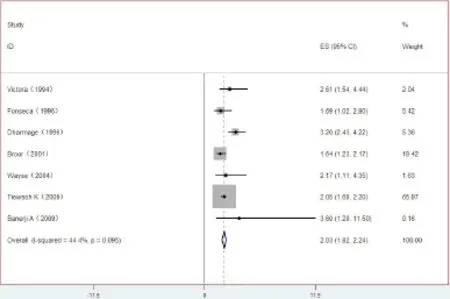
Fig.2 The forest plot of non-breast feeding and childhood ALRI图2 缺乏母乳喂养与儿童ALRI关系的森林图
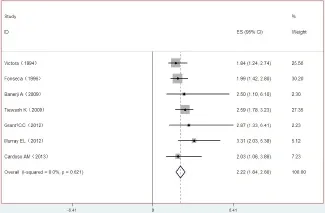
Fig.3 The forest plot of crowded household and childhood ALRI图3 居住条件拥挤与儿童ALRI关系的森林图
2.2.4 室内空气污染10个研究[8,16,22-29]记录了室内空气污染与儿童ALRI的相关性,10篇研究文献不存在异质性(P=0.069,I2=39.7%),采用固定效应模型。结果显示,室内空气污染为儿童ALRI危险因素(OR=1.12,95%CI:1.07~1.17),见图4。
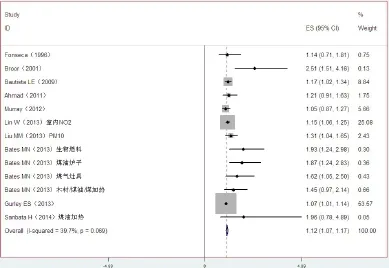
Fig.4 The forest plot of indoor air pollution and childhood ALRI图4 室内空气污染与儿童ALRI关系的森林图
2.2.5 营养不良3个研究[12,20,30]记录了营养不良与儿童ALRI之间的相关性,3篇研究文献不存在异质性(P=0.481,I2=0.0%),采用固定效应模型。结果显示,营养不良为儿童ALRI危险因素(OR=1.31,95%CI:1.12~1.51),见图5。
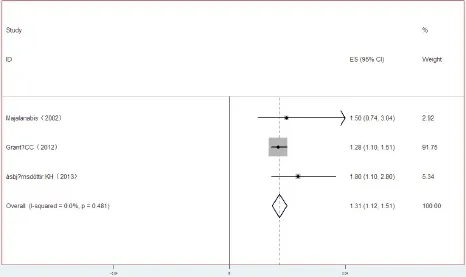
Fig.5 The forest plot of undernutrition and childhood ALRI图5 营养不良与儿童ALRI关系的森林图
2.2.6 处于吸烟环境/孕妇吸烟4个研究[18,20,31-32]记录了处于吸烟环境/孕期吸烟与儿童ALRI之间的相关性,4篇研究文献不存在异质性(P=0.776,I2=0.0),采用固定效应模型。结果显示,处于吸烟环境[18,31-32]或是孕妇吸烟[20]为儿童ALRI危险因素(OR=1.61,95%CI:1.31~1.91),见图6。
2.2.7 HIV接触史(未感染情况)2个研究[12,33]记录了HIV接触史与儿童ALRI之间的相关性,2篇研究文献不存在异质性(P=0.187,I2=42.5%),采用固定效应模型。结果显示,HIV接触史为儿童ALRI危险因素(OR=1.26,95%CI:1.02~1.49),见图7。
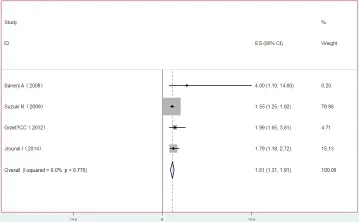
Fig.6 The forest plot of living in a house with smokers or smoking in pregnant and childhood ALRI图6 处于吸烟环境或孕期吸烟与儿童ACRI关系的森林图
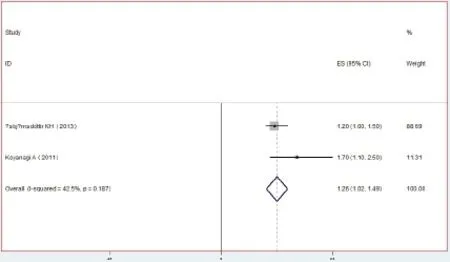
Fig.7 The forest plot of HIV-exposed uninfected children图7 接触过HIV(未感染情况)与儿童ALRI关系的森林图
2.3 各研究发表偏倚分析低出生体质量和室内空气污染对应的文献存在发表偏倚(Z分别为2.35和2.38,P<0.05),缺乏母乳喂养、居住条件拥挤、营养不良、吸烟环境和HIV感染对应的文献都不存在发表偏倚(Z分别为0.90、0.00、0.00、0.70和0.00,均P>0.05)。
3 讨论
ALRI是儿科的常见疾病,是导致儿童死亡的主要原因。大多数早产儿和小于胎龄儿均是低出生体质量儿,体质量不足2 500 g[25]。低出生体质量儿的主要缺陷是呼吸中枢及器官发育不成熟,缺乏肺泡表面活性物质,从母体中获得的抗体相对少。因此,低出生体质量儿较易引起ALRI。本研究以“低出生体质量”和“儿童急性下呼吸道感染(ALRI)”为关键词筛选并纳入的8篇文献,均报道了低出生体质量儿是ALRI的主要危险因素,说明低出生体质量与儿童ALRI紧密相关。
母乳中的表皮生长因子可帮助诱导肠上皮细胞成熟,免疫球蛋白A和低聚糖可防止病原体黏附,而乳铁蛋白具有广谱抗微生物特性,包括破坏细菌外膜[26-27]。纯母乳喂养可以减少婴儿发生感染性疾病的危险[28]。缺乏母乳喂养可增加疾病的严重程度,包括接受住院治疗和住院的频率。关于缺乏母乳喂养可引起儿童ALRI的文献报道很多,本研究经筛选后有7篇文献纳入到危险因素Meta分析中,结果显示缺乏母乳喂养是儿童ALRI的主要危险因素。
居住条件拥挤、室内空气污染(做饭使用燃料)、处于吸烟环境(或孕妇吸烟)均是室内空气污染的最主要污染源。为了节能,现代建筑在设计时倾向于使用非透气材料,居住者人数、做饭使用燃料及所释放的油烟和家庭成员吸烟行为都是室内空气质量好坏的决定性因素。烟草或植物燃烧产生的烟雾含有很多包裹着复杂有机化合物的碳基颗粒,这些微尘颗粒足够小,使其能够避开人体呼吸道系统的防御机能,并深入肺组织,对于儿童甚至婴幼儿的健康构成了最大的潜在威胁。本研究发现,房间拥挤、室内空气污染(做饭使用燃料)、处于吸烟环境(或孕妇吸烟)都是儿童ALRI的主要危险因素。
喂养不当、饮食习惯不良和疾病因素是营养不良的主要病因。长期摄食不足、人工喂养者和不恰当的断奶期是婴儿营养不良的主要因素。可见,本研究报道的各危险因素之间也是互为因果关系,相辅相成的。有关营养不良的报道在本研究共筛选到4篇文献,其中有1篇报道的95%CI是无效的,因此,仅对3篇文献进行了分析,证实了营养不良是造成儿童ALRI的主要危险因素。
有HIV接触史(未感染情况)的婴幼儿比无HIV接触史的婴幼儿具有更高的发病率和病死率,可能是这个弱势群体面临的健康问题[9]。本研究只筛选到2篇文献报道了HIV接触史(未感染情况)与儿童ALRI的关系,结果表明HIV接触史(未感染情况)是儿童ALRI的主要危险因素。
另外,纳入本研究的文献还报道了其他儿童ALRI的危险因素,由于这些危险因素报道频次较少,不符合Meta分析的要求,因此,本次Meta分析不予以统计分析。本文还对每个研究对应的文献逐个进行发表偏倚分析。Begg's检验结果显示,低出生体质量和室内空气污染对应的文献存在发表偏倚,可能的原因是纳入的文献中存在样本量小,设计简单的研究。由于文献质量的限制,尚需更多设计良好的多中心、大样本的随机对照试验加以验证,并再次进行Meta分析以便为临床提供更好的证据。
[1]Lozano R,Naghavi M,Foreman K,et al.Global and regional mortal⁃ity from 235 causes of death for 20 age groups in 1990 and 2010:a systematic analysis for the Global Burden of Disease Study 2010[J]. Lancet,2012,380(9859):2095-2128.doi:10.1016/S0140-6736(12)61728-0.
[2]Kwon HJ,Rhie YJ,Seo WH,et al.Clinical manifestations of respira⁃ tory adenoviral infection among hospitalized children in Korea[J]. Pediatr Int,2013,55(4):450-454.doi:10.1111/ped.12108.
[3]Liu L,Johnson HL,Cousens S,et al.Global,regional,and national causes of child mortality:an updated systematic analysis for 2010 with time trends since 2000[J].Lancet,2012,379:2151-2161.doi:10.1016/S0140-6736(12)60560-1.
[4]Persell SD,Friedberg MW,Meeker D,et al.Use of behavioral eco⁃nomics and social psychology to improve treatment of acute respira⁃tory infections(BEARI):rationale and design of a cluster random⁃ized controlled trial[1RC4AG039115-01]-study protocol and baseline practice and provider characteristics[J].BMC Infectious Diseases,2013,13:290.doi:10.1186/1471-2334-13-290.
[5]Woodhead M,Blasi F,Ewig S,et al.Guidelines for the management of adult lower respiratory tract infections--summary[J].Clin Micro⁃biol Infect,2011,17 Suppl 6:1-24.doi:10.1111/j.1469-0691. 2011.03602.x.
[6]Song JW,Chung KC.Observational studies:cohort and case-con⁃trol studies[J].Plast Reconstr Surg,2010,126(6):2234-2242.doi:10.1097/PRS.0b013e3181f44abc.
[7]Victora CG,Fuchs SC,Flores JA,et al.Risk factors for pneumonia among children in a Brazilian metropolitan area[J].Pediatrics,1994,93(6 Pt 1):977-985.
[8]Fonseca W,Kirkwood BR,Misago C.Factors related to child care increase the risk of pneumonia among children living in a poor com⁃munity in northeast Brazil[J].J Trop Pediatr,1997,43(2):123-124. doi:10.1093/tropej/43.2.123.
[9]Coles CL,Fraser D,Givon-Lavi N,et al.Nutritional status and diar⁃rheal illness as independent risk factors for alveolar pneumonia[J].Am J Epidemiol,2005,162(10):999-1007.doi:10.1093/aje/kwi312.
[10]Tiewsoh K,Lodha R,Pandey RM,et al.Factors determining the out⁃come of children hospitalized with severe pneumonia[J].BMC Pedi⁃atr,2009,9:15.doi:10.1186/1471-2431-9-15.
[11]Misra P,Srivastava R,Krishnan A,et al.Indoor air pollution-relat⁃ed acute lower respiratory infections and low birth weight:a system⁃atic review[J].J Trop Pediatr,2012,58(6):457-466.doi:10.1093/ tropej/fms017.
[12]Ásbjörnsdóttir KH,Slyker JA,Weiss NS,et al.Breastfeeding is as⁃sociated with decreased pneumonia incidence among HIV-exposed,uninfected Kenyan infants[J].AIDS,2013,27(17):2809-2815.doi:10.1097/01.aids.0000432540.59786.6d.
[13]Cardoso AM,Coimbra CE Jr,Werneck GL.Risk factors for hospital admission due to acute lower respiratory tract infection in Guarani indigenous children in southern Brazil:a population-based casecontrol study[J].Trop Med Int Health,2013,18(5):596-607.doi:10.1111/tmi.12081.
[14]Zhang XB,Liu LJ,Qian LL,et al.Clinical characteristics and risk factors of severe respiratory syncytial virus-associated acute low⁃er respiratory tract infections in hospitalized infants[J].World J Pe⁃diatr,2014,10(4):360-364.doi:10.1007/s12519-014-0513-x.
[15]Dharmage SC,Rajapaksa LC,Fernando DN.Risk factors of acute lower respiratory tract infections in children under five years of age[J].Southeast Asian J Trop Med Public Health,1996,27(1):107-110.PMID:9031411.
[16]Broor S,Pandey RM,Ghosh M,et al.Risk factors for severe acutelower respiratory tract infection in under-five children[J].Indian Pe⁃diatr,2001,38(12):1361-1369.
[17]Wayse V,Yousafzai A,Mogale K,et al.Association of subclinical vitamin D deficiency with severe acute lower respiratory infection in Indian children under 5 y[J].Eur J Clin Nutr,2004,58(4):563-567. doi:10.1038/sj.ejcn.1601845.
[18]Banerji A,Greenberg D,White LF,et al.Risk factors and viruses associated with hospitalization due to lower respiratory tract infections in Canadian Inuit children:a case-control study[J].Pediatr Infect Dis J,2009,28(8):697-701.doi:10.1097/INF.0b013e31819f1f89.
[19]Boccolini CS,Carvalho ML,Oliveira MI,et al.Breastfeeding can prevent hospitalization for pneumonia among children under 1 year old[J].J Pediatr(Rio J),2011,87(5):399-404.doi:10.2223/JPED.2136.
[20]Grant CC,Emery D,Milne T,et al.Risk factors for community-ac⁃quired pneumonia in pre-school-aged children[J].J Paediatr Child Health,2012,48(5):402-412.doi:10.1111/j.1440-1754.2011. 02244.x.
[21]Murray EL,Klein M,Brondi L,et al.Rainfall,household crowding,and acute respiratory infections in the tropics[J].Epidemiol In⁃fect,2012,140(1):78-86.doi:10.1017/S0950268811000252.
[22]Bautista LE,Correa A,Baumgartner J,et al.Indoor charcoal smoke and acute respiratory infections in young children in the Dominican Republic[J].Am J Epidemiol,2009,169(5):572-580.doi:10.1093/ aje/kwn372.
[23]Ahmad I,Shaheen N,Khan S.Risk factors for pneumonia among hospitalized children between 2 months to 5 years[J].Pak J Med Sci,2011,19(2):89-94.
[24]Murray EL,Brondi L,Kleinbaum D,et al.Cooking fuel type,house⁃hold ventilation,and the risk of acute lower respiratory illness in ur⁃ban Bangladeshi children:a longitudinal study[J].Indoor Air,2012,22(2):132-139.doi:10.1111/j.1600-0668.2011.00754.x.
[25]Lin W,Brunekreef B,Gehring U.Meta-analysis of the effects of in⁃door nitrogen dioxide and gas cooking on asthma and wheeze in chil⁃dren[J].Int J Epidemiol,2013,42(6):1724-1737.doi:10.1093/ije/ dyt150.
[26]Liu MM,Wang D,Zhao Y,et al.Effects of outdoor and indoor air pollution on respiratory health of Chinese children from 50 kinder⁃gartens[J].J Epidemiol,2013,23(4):280-287.doi:10.2188/jea. JE20120175.
[27]Bates MN,Chandyo RK,Valentiner-Branth P,et al.Acute lower re⁃spiratory infection in childhood and household fuel use in Bhak⁃tapur,Nepal[J].Environ Health Perspect,2013,121(5):637-642. doi:10.1289/ehp.1205491.
[28]Gurley ES,Homaira N,Salje H,et al.Indoor exposure to particulate matterandtheincidenceof acute lower respiratory infec⁃tions among children:abirthcohortstudyinurbanBangladesh[J].In⁃door Air,2013,23(5):379-386.doi:10.1111/ina.12038.
[29]Sanbata H,Asfaw A,Kumie A.Association of biomass fuel use with acute respiratory infections among under-five children in a slum urban of Addis Ababa,Ethiopia[J].BMC Public Health,2014,14:1122.doi:10.1186/1471-2458-14-1122.
[30]Mahalanabis D,Gupta S,Paul D,et al.Risk factors for pneumonia in infants and young children and the role of solid fuel for cooking:a case-control study[J].Epidemiol Infect,2002,129(1):65-71.
[31]Suzuki M,Thiem VD,Yanai H,et al.Association of environmental tobacco smoking exposure with an increased risk of hospital admis⁃sions for pneumonia in children under 5 years of age in Vietnam[J]. Thorax,2009,64(6):484-489.doi:10.1136/thx.2008.106385.
[32]Jroundi I,Mahraoui C,Benmessaoud R,et al.Risk factors for a poor outcome among children admitted with clinically severe pneumonia to a university hospital in Rabat,Morocco[J].Int J Infect Dis,2014,28:164-170.doi:10.1016/j.ijid.2014.07.027.
[33]Koyanagi A,Humphrey JH,Moulton LH,et al.Predictive value of weight loss on mortality of HIV-positive mothers in a prolonged breastfeeding setting[J].AIDS Res Hum Retroviruses,2011,27(11):
(2015-01-23收稿2015-05-12修回)
(本文编辑魏杰)
Meta-analysis of risk factors of severe acute lower respiratory infections in children
FU Zhuo1,WAN Liya1△,XU Yongsheng1,ZHENG Yuejie2
1 Tianjin Children's Hospital,Tianjin 300134,China;2 Zunyi Medical University,Shenzhen Children's Hospital△
ObjectiveTo identify the risk factors for severe acute lower respiratory infections(ALRI)in children and to provide scientific basis for prevention and treatment of ALRI.MethodsSeveral databases including Pubmed,Databases-Medline(Ovid),Embase,CINAHL and Global Health Library,CNKI,VIP and Wanfang Date were searched(1990.1-2014.12)for
.All selected studies were about risk factors of ALRI in children.The screening and quality evalua⁃tion of the literature data was conducted independently by two reviewers according to the inclusion and exclusion criteria. Stata 11.0 software was used for Meta-analysis.ResultsMeta-analysis of 27 included literature showed that seven risk fac⁃tors were significantly associated with severe ALRI:low birth weight,lack of exclusive breastfeeding,crowded household,ex⁃posure to indoor air pollution,malnutrition,living in a house with smokers or smoking in pregnant and HIV-exposed unin⁃fected condition.ConclusionThe above seven risk factors play the important role in the development of ALRI in children. Furthermore,it emphasizes the need for further studies investigating other potential risk factors to decrease the possibility of childhood ALRI.
respiratory tract infections;acute disease;risk factors;meta-analysis;child
R725.6
A
10.11958/j.issn.0253-9896.2015.09.033
1天津市儿童医院呼吸科(邮编300134);2遵义医学院深圳儿童医院
付卓(1977),女,硕士研究生,主要从事小儿呼吸内科方面研究
△通讯作者E-mail:wanliya_1209@163.com
